
He stopped taking nmn because he saw mixed results. He also had new questions about if it is safe to use for a long time. New studies show nmn can raise NAD+ levels by up to 14%. But the effects are often small or not steady, especially at normal doses.
| Parameter/Outcome | Dosage Range (mg/day) | Findings | Notes |
| Blood NAD+ Concentration | 100 - 2000 | Results are mixed. Some studies show big increases, up to 14%. Others show little or even less. | How you measure and handle samples changes results. Higher doses give bigger increases. |
| Aerobic Performance (e.g., 6-min walk, VT) | 300 - 1200 | Higher doses help people walk farther and do better in tests. | Exercise and NMN together work even better. |
| Muscle Mass and Strength | 250 - 900 | No steady big improvements. Some people feel a little stronger. | Lower doses like 250 mg may not be enough. Results are mixed in different studies. |
| Safety and Tolerability | Up to 2000 | All studies say it is safe and easy to handle. | No serious bad effects were found. |
| Time-dependent Intake Effects | 250 | Taking it in the afternoon helps people do better on tests. It also makes them less sleepy. | This might be because it helps people sleep better. More study is needed. |
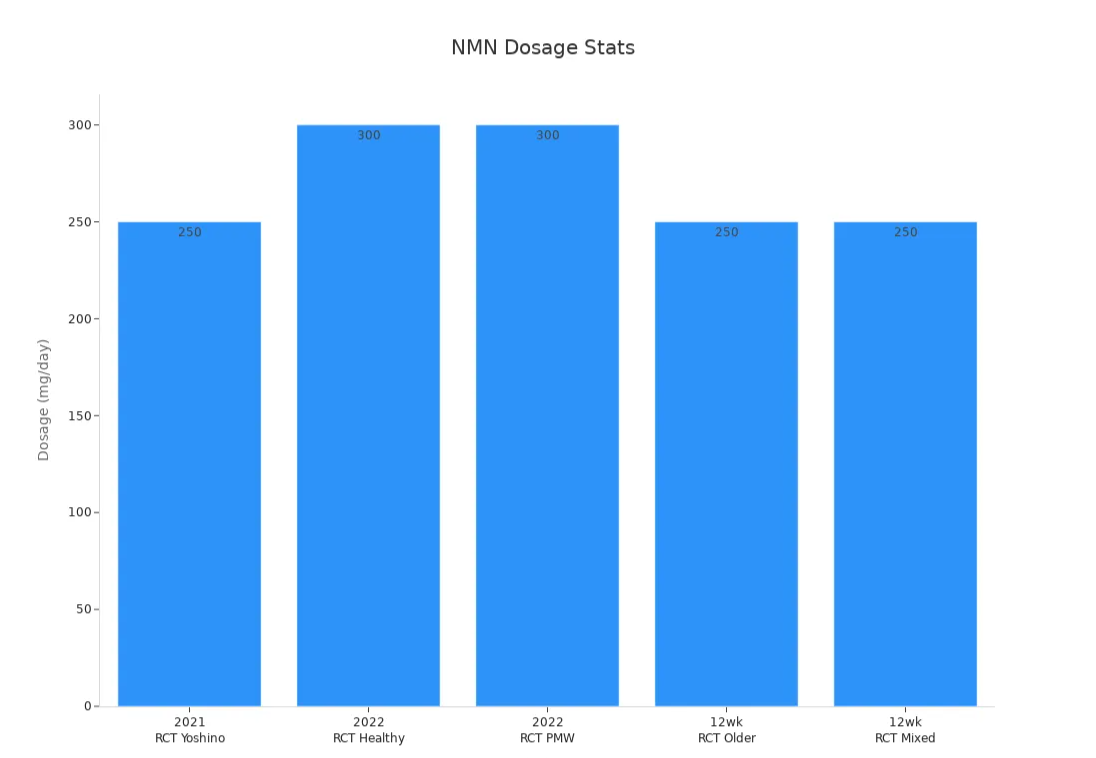
He likes to keep learning from new research and his own experience. Many people think nmn is safe. But he worries about the price and new rules. He wants readers to think about their own supplements. He also wants them to check updates from places like the FDA.
Key Takeaways
NMN supplements can make NAD+ levels go up, but they often give only small or mixed health and energy benefits. Not everyone feels better from NMN; results change for each person and how much they take. We do not know if NMN is safe to use for a long time; more studies are needed to find out about risks. NMN supplements can cost a lot, and some brands may not have the amount they say. Rules about NMN are changing, so look at trusted places like the FDA before you buy. Niacin and other supplements can also help NAD+ and may be cheaper than NMN. Healthy habits like moving your body, sleeping well, and eating good foods help NAD+ in your body. Always talk to a doctor before you start or stop taking NMN or other supplements.
Main Reasons for Stopping NMN
Effectiveness Concerns
He took NMN because he wanted to be healthier and slow aging. He thought NMN would help his NAD+ go up and give him more energy. He read many studies but saw the results were not always clear. Some people in the studies had a small rise in NAD+, but others did not. The results changed based on the dose, how NAD+ was checked, and when people took NMN.
He also saw that health and aging benefits were weaker than he hoped. Some studies showed people could walk a little farther or felt less tired, but the changes were small. He learned NMN does not work the same for everyone. Some people feel better, but others do not notice anything. This made him wonder if NMN was worth it for his own health.
Many people, even doctors like Dr. Brad Stanfield, switched to other NAD+ boosters like niacin after seeing mixed results with NMN.
Safety and Research Gaps
He got more worried about NMN safety after reading new studies. One study on old mice showed that taking NMN by mouth made some chemicals build up. This caused kidney swelling in the mice. The mice got much more NMN than people usually take, but it still made him think about risks, especially for people who take a lot.
Other studies gave high NMN doses to mice and dogs for a short time. Most side effects were small, like tiny changes in liver or kidney tests. But these studies only lasted a week or two. No one knows what happens if people take NMN for months or years. The scientists said more studies are needed to check for long-term risks, like kidney problems, differences between men and women, and signs of swelling.
He saw that NMN and other NAD+ boosters are not well checked by rules. This means there are not enough safety checks or info about how NMN affects people over time. He chose not to risk his health until more research is done.
Regulatory Issues
He also watched the changing rules about NMN. The FDA made many choices about NMN in the last few years:
He saw these rule changes made it harder to trust NMN products. Now he checks the FDA and other trusted places before picking new supplements.
Cost-Benefit
He started to notice that NMN supplements cost a lot. Some bottles sell for over $50, and many brands charge even more for higher doses. He wanted to know if the price matched the benefits. He found that not all NMN products are the same. Some brands put less NMN in the bottle than the label says. Labs use special machines, like HPLC-QqQ-MS, to check if the amount on the label is true. Sometimes, the real NMN is much lower than promised. This made him question if he was getting what he paid for.
He also learned that how people take NMN changes how much their bodies use. Powders and sublingual tablets work better than capsules. Capsules break down in the stomach, so less NMN gets into the blood. He realized that even if he paid more for a product, he might not get better results if the delivery method was not right.
“Paying more does not always mean getting more,” he thought. “It matters how much NMN is in the bottle and how well my body can use it.”
He looked at the science. Studies show that higher doses of NMN can raise NAD+ levels, but the effect is not always big. Some people need to take a lot to see any change. This means the cost goes up fast. He started to wonder if the small boost in energy or health was worth the high price.
He compared NMN to other options. Niacin, for example, costs much less and also helps raise NAD+ levels. Some doctors, like Dr. Brad Stanfield, switched to niacin because it gives similar results for a lower price.
He now checks every supplement for value. He asks:
Does the product have the right amount of NMN?
Is the delivery method good for absorption?
Are the benefits worth the cost?
He believes everyone should think about these questions before spending money on NMN. He also suggests checking trusted sources, like the FDA, to make sure the product is safe and real.
About NMN
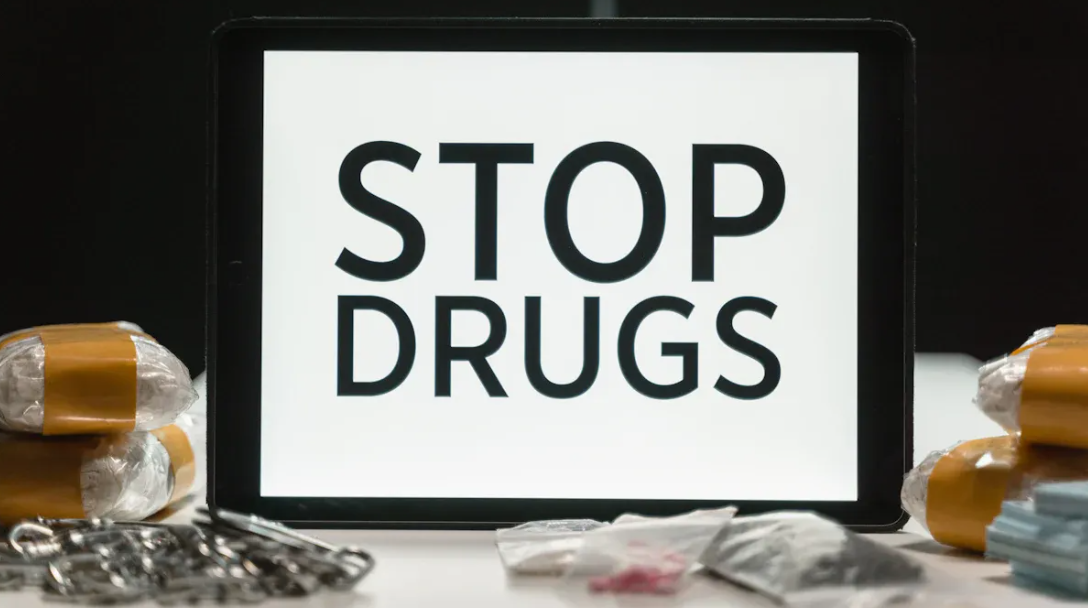
What Is NMN
NMN means nicotinamide mononucleotide. It is a tiny molecule in plants and animals. Scientists call it a NAD+ precursor. The body uses NMN to make NAD+. NAD+ is a coenzyme. It helps cells turn food into energy. It also helps fix DNA and keeps people healthy as they age.
NMN has three main parts. These are a phosphate group, a ribose sugar, and a nicotinamide base. When someone takes NMN, the body absorbs it fast. Then the body turns it into NAD+. This happens in both people and animals. Many people want more NAD+ as they get older. NAD+ levels go down with age.
Some foods have a little NMN. Here is a table that shows how much NMN is in different foods:
| Food Category | Food Item | NMN Content (mg/100g) |
| Vegetables | Broccoli | 0.25 – 1.12 |
| Vegetables | Cucumber seeds | 0.56 |
| Vegetables | Edamame | 0.47 – 1.88 |
| Vegetables | Yellow-flowered peel | 0.65 |
| Vegetables | Cabbage | 0.0 – 0.9 |
| Fruits | Avocado | 0.36 – 1.6 |
| Fruits | Tomato | 0.26 – 0.30 |
| Meat | Raw beef | 0.06 – 0.42 |
| Seafood | Shrimp | 0.22 |
| Other | Mushrooms | 0.0 – 1.01 |
Most people do not get enough NMN from food. That is why some people take NMN supplements. They want to boost their NAD+ levels.
Intended Benefits
Many people take NMN for anti-aging and better health. NMN is popular because people hope it helps them feel younger. Scientists study NMN to see if it helps with aging and energy.
Some research shows NMN supplements can help. Human studies used 250 mg to 1,200 mg per day for up to 60 days. These studies found NMN can raise NAD+ in the blood. Some people walked farther in a 6-minute walk test. Some kept their biological age stable. Here is a table from one study:
| Measure | Placebo Group | 300 mg NMN | 600 mg NMN | 900 mg NMN | Statistical Significance |
| Participants (n) | 20 | 20 | 20 | 20 | N/A |
| Duration | 60 days | 60 days | 60 days | 60 days | N/A |
| Blood NAD Concentration | Baseline | ↑ Significant increase vs placebo and baseline (dose-dependent) | ↑ Significant increase vs placebo and baseline (dose-dependent) | ↑ Significant increase vs placebo and baseline (dose-dependent) | p < 0.05 vs placebo and baseline; dose-dependent between 300 mg and higher doses |
| Biological Age Change (years) | +5.6 | Stable | Stable | Stable | p < 0.05 vs placebo |
| 6-Minute Walk Test Distance (meters) | 330 | 380 | 435 | 480 | p < 0.01 vs placebo; p < 0.05 vs baseline for 600 mg and 900 mg |
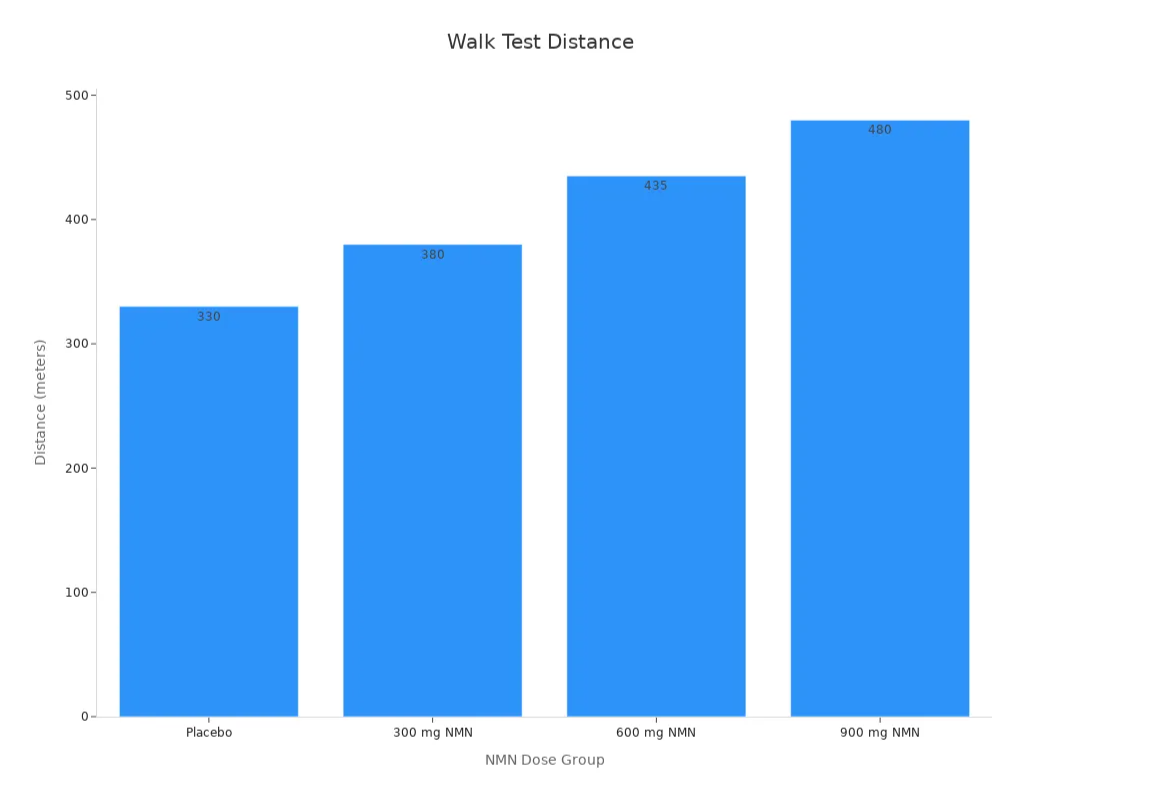
Note: The study showed that bigger NMN doses led to higher NAD+ and better walking distance. But the study had only a few people and lasted just 60 days. Scientists say more research is needed to know if NMN helps long-term.
People hope NMN will help them live longer and stay healthy. Some think it can slow aging and help people live longer. NMN is a NAD+ precursor, so it may help with energy and fixing DNA. It may also help other important body jobs. Still, NMN does not work the same for everyone. Some people feel more energy. Others do not feel much change.
Personal Experience with NMN
Expectations vs. Reality
He started taking NMN with high hopes. He read stories about people feeling younger and more energetic. He expected big changes in his health, like better sleep, sharper thinking, and more energy for daily life. He thought NMN would give him clear benefits, especially since so many people online talked about their positive experiences.
After a few weeks, he noticed some small changes. He felt a little more alert in the mornings. His energy seemed to last longer during the day. But the improvements were not as strong as he expected. He realized that the benefits of NMN might not be as dramatic for everyone. Some days, he felt no different at all. This made him question if the supplement was really working or if the effects were just in his head.
He learned that personal experience with NMN can be very different from what studies or ads promise. Not everyone gets the same results.
Effects While Taking NMN
During his time on NMN, he paid close attention to his body. He tracked his energy, sleep, and mood. He also looked at research to compare his own experience with what scientists found. In one study, people who took NMN showed small but real improvements in physical tests. For example, the Timed Up and Go (TUG) test showed a drop in time from about 5.6 seconds to 5.4 seconds. The 5-meter walk test stayed about the same, but some people felt less tired and had better lower limb function after 12 weeks of 250 mg per day, especially when taken in the afternoon.
| Metric / Test | Pre-Supplementation (Mean ± SD) | Post-Supplementation (Mean ± SD) | Effect Size (Cohen’s d) | p-value |
| Timed Up and Go (TUG) (seconds) | 5.2 to 5.6 ± ~0.6 to 1.3 | 5.0 to 5.4 ± ~0.4 to 1.2 | 0.20 to 0.54 | < 0.01 |
| 5-m Habitual Walk (seconds) | 3.2 to 3.4 ± ~0.4 to 0.7 | 3.2 to 3.4 ± ~0.4 to 0.7 | 0.06 to 0.22 | 0.47 |
He noticed that his energy felt a bit steadier, and he sometimes had better focus. He did not see big changes in his cognitive skills, but he felt less drowsy in the afternoon. Some days, he slept better, but other nights were the same as before. He did not have any major side effects, but he read that other users sometimes felt headaches or stomach upset.
Scientists also found that NMN can help with mood and energy at the molecular level. In animal studies, NMN improved energy use in the brain and body, which could explain why some people feel better while taking it.
After Stopping NMN
When he stopped taking NMN, he watched for changes. At first, he worried that his energy would drop or that he would feel tired. For a few days, he felt a little more sluggish in the morning. His sleep did not change much, but he noticed his afternoon alertness faded a bit. He did not have any strong withdrawal symptoms.
He read online that some people feel fatigue, brain fog, or mood swings after stopping NMN. He did not have these problems, but he saw that personal experience can vary a lot. Some users on forums shared stories about feeling tired or less sharp after quitting NMN. Others said they felt no difference at all.
He realized that the observable benefits of NMN were mild for him. He did not see big changes in his health or cognitive function after stopping. He now thinks that NMN may help some people, but the effects are not always strong or long-lasting. He suggests that anyone thinking about NMN should watch their own health closely and talk to a doctor or check trusted sources like the FDA for advice.
NMN Safety Concerns
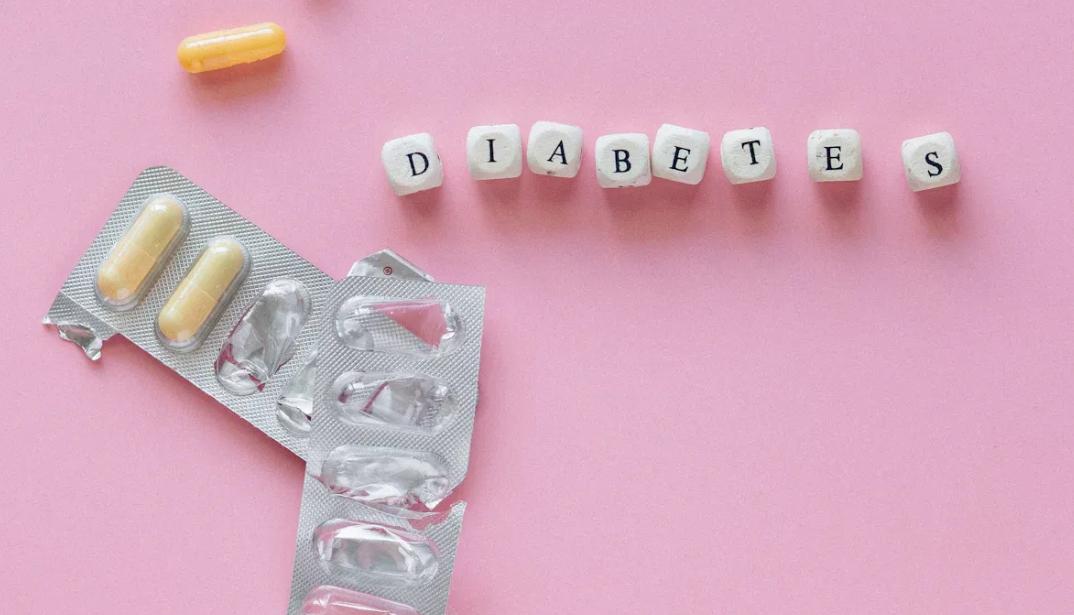
Long-Term Risks
He wanted to know if NMN is safe for long-term use. Many people worry about what happens if you take a supplement every day for a long time. He found a study that gave NMN to mice for a whole year. The scientists checked for bad effects, side effects, and health changes. The results showed no clear signs of harm or serious side effects. The mice did not die more often than normal. Some even got healthier, like having better insulin sensitivity and stronger bones. The scientists used regular health checks and math tests to make sure the results were true.
| Aspect Assessed | Findings | Statistical Methods Used |
| Duration | 12 months | Long-term intervention |
| Toxicity and Side Effects | No obvious toxicity, no serious side effects, no increased mortality | Regular monitoring, Student’s t test, ANOVA |
| Physiological Effects | Suppressed age-related weight gain, better food intake, more energy, improved insulin sensitivity, better bone density | Dose-dependent effects analyzed by ANOVA and posthoc tests |
| Dose Dependency | 100 mg/kg/day often more effective than 300 mg/kg/day for some functions; some gene expression changes at higher dose | One-way ANOVA with linear term, Wilcoxon test |
| Safety Conclusion | Long-term NMN administration appears safe in mice with no revealed risks | Statistical significance at p ≤ 0.05 |
He saw that most long-term studies are done on animals, not people. There are not many studies in humans that last longer than a few months. He thinks people should be careful with long-term use until more is known. He also checks for updates from trusted places like the FDA.
Neurological Symptoms
He wondered if NMN could change how the brain works. Some people online say they get brain fog or headaches from NMN. He found a study that tested NMN in rats with brain injuries. The scientists measured brain water and how well the rats did on memory tests. NMN helped lower brain swelling and made the rats do better on tests. Rats that got NMN remembered things better in the Morris Water Maze.
| Measure | Group Comparison | Numerical Result | Statistical Significance |
| Brain Water Content (edema) | TBI + NMN vs TBI | 79.97% ± 0.16% vs 80.41% ± 0.19% | P < 0.05 |
| Neurological Severity Score (mNSS) | TBI vs Sham | Significantly higher in TBI (P < 0.001) | - |
| Neurological Severity Score (mNSS) | TBI + NMN vs TBI | Significantly reduced after NMN (P < 0.05) | - |
| Morris Water Maze Escape Latency | Days 4-7: TBI vs Sham | Higher in TBI (P < 0.01 to P < 0.001) | - |
| Morris Water Maze Escape Latency | Days 4-7: TBI + NMN vs TBI | Lower in NMN-treated rats (P < 0.05 to P < 0.01) | - |
He saw that NMN might help the brain after injury in animals. But he did not find strong proof about brain side effects in healthy people. He thinks more research is needed to know if NMN changes brain health or causes problems in humans.
NAD+ and Metabolic Changes
He learned that NMN helps the body make more NAD+. NAD+ is important for energy and health. Many studies show NMN can raise NAD+ in the blood and some tissues. How much it goes up depends on the dose, age, and health of the person. Some people see a quick jump in NAD+ after taking NMN, but it may not last long.
| Parameter / Study Aspect | Quantitative Data / Findings |
| NAD+ and related metabolites increase | Increases in NAD+, NAMN, NR, NAR observed after NMN supplementation |
| Tissue-specific NAD+ changes | Increased NAD+ in PBMCs but not in muscle tissue |
| Dose-dependent NAD+ increase | ~15 nmol/L NAD+ increase correlating with improved walking test results |
| NMN dosing and metabolite levels | 250 mg NMN: 2-PY ~2500, 4-PY ~400, 1-MeNAM ~250; 500 mg NMN: 2-PY ~4000, 4-PY ~750, 1-MeNAM ~300 |
| Time-course of NAD+ changes | Rapid NAD+ increase within minutes to hours post-administration; short-term fluctuations return to baseline in ~2 h |
| Brain NAD+ increase (mice) | 500 mg/kg IP NMN increased hippocampal NAD+ by 34–39% within 15 min; 62.5 mg/kg sustained mitochondrial NAD+ for 24 h |
| Metabolic effects | Activation of SIRT1/CD38 pathways; increased insulin sensitivity proteins in muscle despite unchanged muscle NAD+; triglyceride reduction with IV NMN |
| Variability factors | Baseline NAD+ levels, sex, age, ethnicity, lifestyle influence NAD+ response and metabolic outcomes |
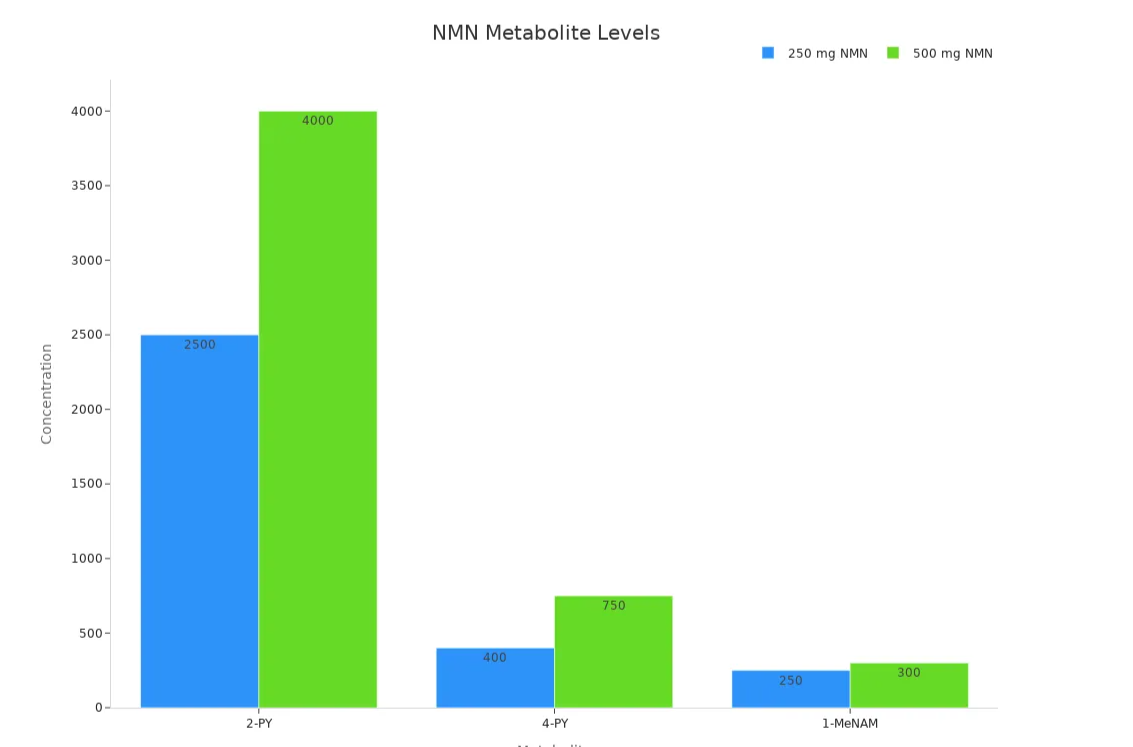
He also read that NMN may help the heart and blood vessels. Some studies show better insulin sensitivity and lower triglycerides, which could lower heart disease risk. He thinks that changes in NAD+ can affect energy, metabolism, and heart health. Still, he knows results can be different for each person. He believes people should watch for side effects and talk to a doctor before starting NMN, especially if they have heart problems.
Alternatives to NMN
Niacin and Other Supplements
He wanted to find new ways to stay healthy after stopping NMN. The first thing he looked at was niacin. Niacin is also called vitamin B3. Doctors have used it for a long time. It helps with cholesterol and heart health. Some people use niacin to raise NAD+ in their bodies.
He learned niacin can help muscles and give more energy, especially for people with health issues. But niacin can cause flushing. Flushing makes your skin feel hot and red. This side effect makes some people stop using niacin. He saw that niacin does not always stop heart attacks or help people live longer. Still, it can help blood fats and muscle health for some people.
He made a table to compare NMN and niacin:
| Supplement | Population & Dose | NAD+ Level Change | Key Physiological Outcomes | Side Effects / Limitations |
| NMN | Healthy adults, 250-300 mg/day, 8-12 weeks | NAD+ increase ranges from ~10% to 6-fold | Some improvements in walking, grip strength, muscle insulin sensitivity; no big changes in body fat, blood pressure, or heart health | Usually safe; benefits are small and not always steady |
| Niacin | Different groups, various doses | Not always measured for NAD+ | Better blood fats, helps muscles in some diseases; does not lower death rates | Flushing is common; not always good for heart or metabolism |
He also read about other supplements that boost NAD+. NR, which stands for nicotinamide riboside, is another choice. NR works like NMN. It helps the body make more NAD+. Some people think NR is easier to take. NR does not cause as much flushing as niacin. He saw that NR and nicotinamide riboside are used in studies about aging and energy. Some people try both NR and niacin to see which one helps them more.
He thinks it is best to talk to a doctor before trying new supplements. Not every supplement works the same for everyone. He likes to read updates from trusted places like the National Institutes of Health to stay safe.
Lifestyle Approaches
He learned that you do not need only supplements to help NAD+ levels. Simple changes in daily life can help, too. Exercise is one of the best things to do. Moving your body every day gives you more energy and keeps NAD+ high. Even walking or riding a bike can help.
Eating healthy foods is important as well. Foods like broccoli, avocado, and mushrooms have a little NMN and other good nutrients. He tries to eat more of these foods. Getting enough sleep is also important. Good sleep helps the body fix itself and keeps energy up.
He found out that stress can lower NAD+ in the body. He tries to relax and spend time with friends and family. Sunlight and fresh air make him feel better. He believes a healthy lifestyle can work with supplements or even take their place for some people.
Tip: He says to start with small steps. Try walking after dinner or eating more green vegetables. Over time, these habits can help NAD+ and make you healthier.
Now he focuses on healthy habits and only uses supplements if he needs them. He feels good knowing he can help his health with simple choices.
Summary
He noticed that taking NMN did not bring the big changes he hoped for. After several months, he saw no real boost in energy, focus, or daily well-being. He started to wonder if the supplement was worth the money. Many people share this feeling. They try NMN, but do not see much difference in how they feel.
Some users report mild side effects. These can include skin itching, redness, or mild rashes. Others mention trouble sleeping, stomach discomfort, or even a stuffy nose. These issues are usually not serious, but they can be annoying.
He also worried about the unknowns. Scientists do not know what happens when people take NMN for years. Some experts warn that raising NAD+ too much could upset the body’s balance. Clinical studies show NMN can increase NAD+ levels, but most studies are small and short. No one knows the long-term effects yet.
He looked at the cost. NMN supplements are expensive. He decided his money might be better spent on things that have more proof, like eating well, moving more, and managing stress. These habits help with aging and support longevity.
Many people stop NMN because they do not notice benefits, worry about safety, or want to save money for proven health choices.
Advice for Readers
He suggests that readers think carefully before starting NMN. Here are some tips:
Ask yourself if you really need a supplement. Sometimes, healthy habits work just as well.
Watch for side effects. If you notice skin changes, sleep problems, or stomach issues, talk to a doctor.
Stay up to date with new research. Trusted sources like the FDA and NIH share important updates.
Think about the cost. If you do not see clear benefits, it may be time to try something else.
Remember that everyone is different. What works for one person may not work for another.
Tip: Focus on habits that help your body every day. Good food, regular exercise, and enough sleep can do a lot for your health.
He believes that making smart choices now can help people feel better as they age. He encourages readers to talk with a healthcare provider before starting or stopping any supplement.
He quit taking NMN because the good effects did not last long. New research made him wonder if NMN is safe or helpful for a long time. Some new studies show NAD+ goes up when people use liposomal NMN. But NAD+ drops again after people stop taking it. The table below shows what happened in the study:
| Group | Intervention | NAD+ Level Change | Statistical Significance |
| Liposomal NMN | 350 mg/day for 4 weeks | Significant increase in NAD+ during intake | p = 0.000 vs placebo; p = 0.001 vs non-liposomal NMN |
| Non-liposomal NMN | 350 mg/day for 4 weeks | No significant increase compared to placebo | p = 0.545 vs placebo (not significant) |
| Placebo | - | Baseline NAD+ levels | Reference group |
| Post-discontinuation | 4 weeks after stopping | Significant decrease in NAD+ compared to peak | p = 0.043 |
He thinks that healthy habits, like moving your body and eating well, help keep NAD+ steady after stopping NMN. He tells people to look for updates from trusted places like the FDA. He also says to talk to a doctor before making changes to any supplement routine.
FAQ
What is NMN used for?
People use NMN to try to boost energy and slow aging. NMN helps the body make NAD+, which supports cell health. Some hope it helps with memory, strength, and feeling younger.
Is NMN safe to take every day?
Most studies say NMN is safe for short-term use. No one knows if it is safe for years. He checks updates from the FDA and talks to his doctor before using any supplement.
Can NMN help with energy or sleep?
Some people feel more energy or better sleep with NMN. Others do not notice any change. The effects can be different for everyone. He suggests tracking how you feel if you try it.
What are the side effects of NMN?
Most people do not have serious side effects. Some report headaches, stomach upset, or skin rashes. If someone feels unwell, he recommends stopping NMN and talking to a healthcare provider.
Are there cheaper alternatives to NMN?
Yes! Niacin and NR (nicotinamide riboside) also raise NAD+ levels. Niacin costs less but can cause flushing. He compares options and checks trusted sources like the NIH.
Should people stop NMN if the FDA changes the rules?
He thinks it is smart to follow new rules and check for updates. If the FDA says to stop, he listens. He always checks labels and buys from trusted brands.
How can someone boost NAD+ without supplements?
He suggests regular exercise, eating healthy foods, and getting enough sleep. These habits help the body make NAD+ naturally. Even small changes, like walking daily, can help.
Tip: Always talk to a doctor before starting or stopping any supplement. Stay informed with updates from trusted sources.
















